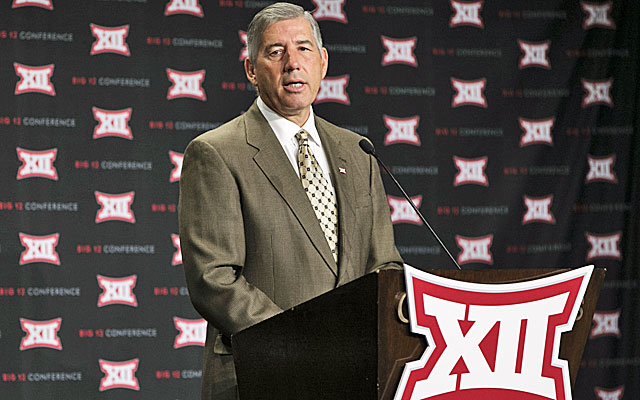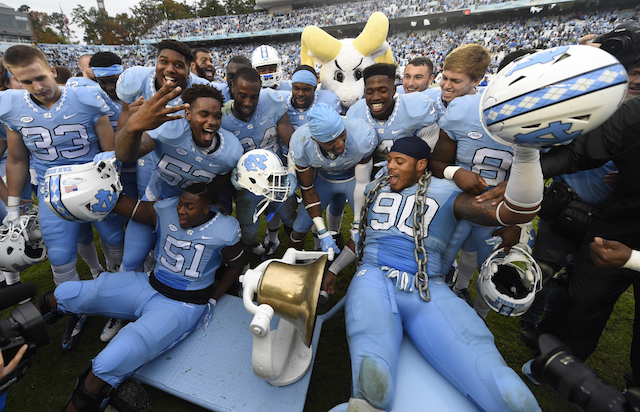Without a championship game, Sooners sit while others make final impression
Following a weekend where No. 1 Clemson, No. 2 Alabama, and No. 3 Oklahoma fortified their standings with compelling rivalry triumphs, while No. 6 Notre Dame experienced a heart-wrenching defeat via a last-second field goal, the forthcoming quartet for the College Football Playoff appears oddly foreseeable.
A sense of predictability looms, and the fourth spot in the playoff is seemingly reserved for the victor of the upcoming Big Ten championship featuring No. 4 Iowa against No. 5 Michigan State.
This expectation hinges on the premise that Alabama and Clemson will prevail in their respective conference title clashes.
Naturally, this recurring situation resurfaces the perennial debate: Should all Power 5 conferences be mandated to conduct a championship game?
While Oklahoma’s resurgence has been noteworthy, their credentials remain on hold as other contenders get ample opportunities to exhibit their prowess, capitalizing on the committee’s penchant for championship game victories and impactful displays on the grand stage.
However, a notable hurdle exists for the Big 12. Its mere composition of 10 schools restricts the hosting of a championship game, a limitation imposed by NCAA regulations demanding a minimum of 12 members.
In this context, the discourse shifts from the question of whether the Big 12 should be granted permission to host such a game (a stance I advocate), to assessing whether an additional contest constitutes an advantageous or disadvantageous scenario.
The pivotal matter at hand revolves around the potential implications of this extra layer of competition.

To Play or Not to Play
In the previous season, Baylor and TCU both closed out the regular season with impressive 11-1 records, leading to a co-Big 12 championship.
The absence of a tiebreaker mechanism at that time (now implemented in the Big 12) meant that the conference couldn’t definitively declare a sole champion. Consequently, the playoff committee refrained from designating a victor either.
Subsequently, neither Baylor nor TCU secured a place in the playoff. This raises the question: Was the Big 12’s exclusion due to the lack of a conference title game, or were there other factors at play, such as the outcome of the Big Ten championship game?
It’s conceivable that Ohio State’s triumph in the Big Ten championship, along with their impressive 12-1 record, was a key factor in distinguishing them from the 11-1 records of TCU and Baylor.
However, the manner in which Ohio State secured its victory held additional weight. Armed with a third-string quarterback, the Buckeyes emphatically dominated Wisconsin with a resounding 59-0 victory.
It was this extraordinary display in their 13th game that set Ohio State apart from their Big 12 counterparts, who had concluded their regular seasons a week earlier.
The spotlight subsequently turned to the Big 12’s absence of a formally named conference championship game.
This topic became a focal point during the offseason, prompting conversations about the potential impact on playoff inclusion. Commissioner Bob Bowlsby expressed his reluctance to adopt changes after just a single year of the College Football Playoff system’s implementation.
His belief was anchored in the confidence that the Big 12’s nine-game round-robin format, coupled with the new head-to-head tiebreaker strategy, would effectively enhance the chances of Big 12 champions securing coveted playoff spots.
Fast forward to this year, and it appears that this strategic adjustment has indeed yielded positive outcomes.

Given the Big 12’s strategic “not by our design” back-loaded schedule for this season, the emergence of Oklahoma as the conference champion appeared highly unlikely.
Overcoming the shadow of their disheartening 24-17 loss to Texas – a squad currently holding a 4-7 record, slated to become 4-8 after a forthcoming showdown against Baylor – is a feat that underscored the Sooners’ resilience.
This remarkable turnaround saw them rise from a lowly No. 15 ranking to a remarkable No. 3 standing in the previous week’s rankings.
Curiously mirroring the narrative, last season witnessed Ohio State’s ascent from the same No. 15 spot after an early stumble against Virginia Tech, culminating in their victorious claim of the playoff championship.
While time will reveal if the Sooners replicate Ohio State’s journey, the parallels are evident. It’s noteworthy that the Buckeyes had to earn their playoff berth through a compelling display in the Big Ten title game.
Interestingly, the lack of a championship game on Oklahoma’s horizon bestows an extra week to mend and refine their preparation for the impending semifinal clash. This advantage is undoubtedly coveted by any team.
In stark contrast, Clemson finds itself in a challenging predicament – locked in a clash with the formidable North Carolina Tar Heels in the ACC championship game.
The Tar Heels, fueled by a nothing-to-lose mentality and everything to gain, pose a formidable challenge. This juxtaposition accentuates the value of the respite that an additional week of preparation can offer.

Coaches universally shun the prospect of jeopardizing an unblemished record or risking the health of a star player due to injury concerns.
Particularly in the case of the Tigers, who already clinched the No. 1 spot, there’s little room for upward movement.
Examining this angle, it’s plausible to argue that an advantage surfaces for Oklahoma or any Big 12 contender securing a conference title sans the 13th game.
A notable point of contention arises in the potential semifinal matchups. If the top three teams remain unchanged, a scenario unfolds where No. 2 Alabama squares off against No. 3 Oklahoma in the Cotton Bowl.
The semis are organized so that the No. 1 seed claims the geographically closer of the two bowl venues, which this season translates to the Orange Bowl.
Consequently, Clemson would take on the victor of the Big Ten in Miami, while Alabama would essentially enjoy a home-field advantage in Dallas.
However, an intriguing facet emerges – given the relative proximity of Norman to Dallas compared to Tuscaloosa, the Sooners find themselves in a situation akin to a home game.
Yet, I’m not wholeheartedly convinced that these rankings will remain static. My prediction is that the Big Ten champion will ascend to the third spot, nudging Oklahoma to fourth.
This speculation is partly driven by the fortunate absence of a plausible one-loss team sitting at No. 5, poised to leapfrog over the existing lineup.
This realization leaves us pondering the significance of the situation a mere week from Tuesday.
Engaging in that additional game, coupled with a commendable performance, has the potential to eradicate these speculative scenarios, ensuring that future Big 12 contenders are shielded from being surpassed by inferior teams on the championship weekend.
This emphasis on on-field performance, rather than hypotheticals, assumes paramount importance.
The “What Ifs”
Engaging in the annual exercise of exploring “what-if” scenarios is undoubtedly entertaining, even if they tend to remain largely implausible.
This year, however, a couple of scenarios loom that could disrupt the carefully crafted plans of the playoffs.
The outlook for the Big Ten champion securing a spot seems almost certain, similarly, Alabama’s victory over Florida in the SEC championship appears likely. Consequently, our attention pivots towards the North Carolina vs. Clemson face-off.
Should the Tar Heels manage a triumph (although that’s a significant hurdle), does this victory suffice to replace Clemson in the playoff lineup? The playoff committee frequently references the attainment of championships as one of its core criteria.
Will they uphold this principle in their decision-making?
North Carolina, ranked at No. 14 last week, raises questions about how far their position could soar following a road victory against N.C. State.
However, the Tar Heels’ strength of schedule emerges as a sore point, one of the weakest among the top 14 teams, rivaled only by Iowa.
Their one-loss record carries the blemish of a disappointing defeat against South Carolina (17-13), a team sporting a meager 3-9 record.
It’s pertinent to inquire whether the playoff committee would truly disregard their criteria and overlook a one-loss conference champion like North Carolina in favor of a non-conference champion.
Yet, the perplexing case of No. 9 Stanford, ranked ahead of No. 16 Northwestern last week, complicates matters.
Despite Northwestern’s victory over Stanford at the onset of the season and their shared records, the former found itself trailing in rankings.
Deciphering the reasoning behind this decision presents a challenging puzzle, reminding us that football dynamics can be enigmatic at times.
Enter Stanford’s two-loss potential inclusion. If they triumph over Southern Cal for a second time in the Pac-12 championship game, an unforeseen path opens for a two-loss Pac-12 team to potentially eclipse one-loss Oklahoma in the rankings.
The ensuing consequences could accelerate Bob Bowsby’s contemplations on introducing a championship game. In this hypothetical scenario, the prospect of welcoming new conference members would loom large.
In a realm where uncertainty thrives, these intriguing possibilities serve as a tantalizing reminder that football’s unpredictability endures.

This highlights the difference between the college football playoff and the NFL playoffs. The NFL places high significance on division winners.
If you win, you are in the postseason. This isn’t an apples-to-apples comparison, but it does bring to light a couple of interesting thoughts. It places importance on winning your conference in order to make it to the postseason.
The 2014 Carolina Panthers won the NFC South at 7-8-1 and won their Wild-Card round game.
The Seattle Seahawks went 7-9 in 2010 and also won their Wild Card game. Maybe this makes the argument that a perceived “lesser” team in UNC should get a chance to compete in the CFB playoff if it wins the ACC championship.
Or is college pleased that they don’t create that opportunity?
Whatever the outcome, it’s clear there a still likely to be points of tension with this playoff. Nevertheless, after a season-long roller-coaster ride, it appears we have begun our descent into a smooth landing for most of the playoff spots.
But it’s that last one that’s always going to be the kicker…

